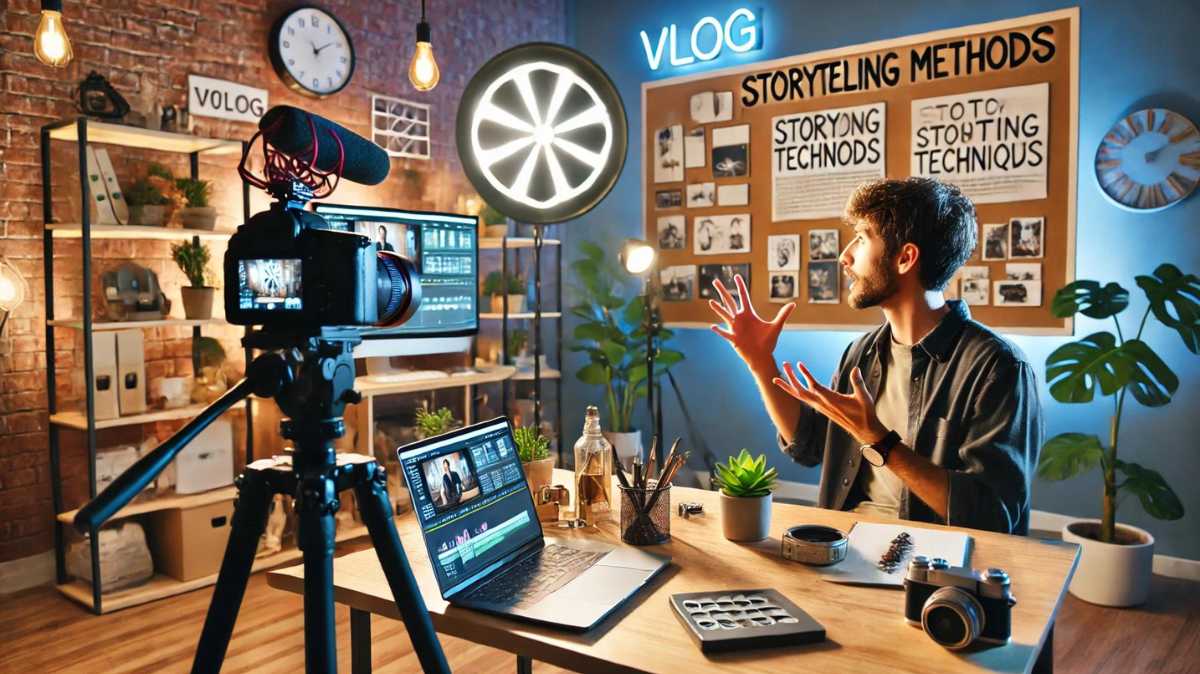Vlogs have emerged as a dynamic way for content creators to connect with audiences across the globe. Whether it’s sharing daily routines, travel experiences, or imparting knowledge, vlogs offer a platform for visual storytelling that transcends traditional media. But beyond the camera, equipment, and editing software lies the heart of a vlog: the story. Mastering vlog storytelling methods is essential if you want to captivate viewers and keep them coming back for more. In this guide, we’ll learn deep into the most effective vlog storytelling methods, offering techniques that will not only boost engagement but also help rank your content on platforms like YouTube, and even on search engines like Bing.
Table of Contents
Understanding the Power of Storytelling in Vlogging
Storytelling is about connecting with people. It’s the emotional and intellectual bond you create with your audience through a narrative. In the context of vlogging, storytelling transforms a mundane video into an immersive experience. But why is storytelling so crucial in vlogs?
People love stories. They engage with content that resonates with them emotionally, whether it makes them laugh, cry, or think. Vlogs are a perfect medium to tap into this human inclination. By adding a clear narrative structure to your vlogs, you ensure viewers not only stay glued to the content but are also more likely to share and recommend it.
Crafting a Compelling Vlog Narrative
A successful vlog narrative, much like a film, follows a structure. The essential elements include:
Introduction: Capturing attention from the get-go is crucial. This can be a teaser of what’s to come or an engaging hook that makes viewers want to keep watching.
Setting the Scene: Give your audience context. Whether you’re at a beach, in a café, or at home, painting a picture of where you are helps ground the story.
Building Tension: Every good story has some form of conflict or tension. In a vlog, this might be a challenge you’re overcoming, a mystery you’re unraveling, or an adventure you’re embarking on.
Resolution: How does your story end? What did you learn or achieve? This provides closure and satisfies your audience.
Pro Tip: Try introducing a problem or question at the beginning of your vlog and then resolving it by the end. This creates a satisfying loop that keeps viewers engaged.
The Hero’s Journey in Vlogging
The Hero’s Journey, a storytelling framework popularized by Joseph Campbell, is often used in films and books, but it can be seamlessly adapted to vlogs. In this structure:
The Ordinary World: Show your audience what your daily life or current situation looks like.
Call to Adventure: Introduce a challenge or goal. For example, “I’m trying to hike to the top of this mountain,” or “I’m attempting a 24-hour food challenge.”
Crossing the Threshold: Take your audience along as you embark on this journey. What obstacles do you face?
The Reward: Showcase the final achievement or realization.
In vlogs, this method provides a clear journey, turning even simple activities into engaging stories.
The Importance of Authenticity
In the age of influencers, audiences are bombarded with content daily. What sets successful vloggers apart is authenticity. People can easily detect when someone isn’t being genuine. Be yourself in front of the camera. Share your true thoughts, feelings, and experiences. This honesty builds trust, which is vital for audience retention and growth.
When you share personal anecdotes, viewers feel a stronger connection to your story, making them more invested in your journey. Authenticity also breeds relatability, and relatable content is often the most shareable.
Visual Storytelling Techniques in Vlogging
While verbal storytelling is crucial, vlogs have the added advantage of visual elements. Incorporating compelling visuals can significantly enhance your narrative:
Establishing Shots: Start with a wide shot to set the context. For instance, if you’re traveling, a sweeping view of the city or landscape can instantly draw viewers into your world.
B-Roll Footage: These are supplementary shots that enhance your primary narrative. If you’re explaining a task, cut to close-ups of your hands working, or zoom in on details that add depth to your story.
Visual Metaphors: Use objects or actions to symbolize larger ideas. For example, showing a clock ticking can represent the passage of time or impending deadlines.
Using Emotion to Drive Your Story
One of the most powerful tools in a storyteller’s arsenal is emotion. Stories that make people feel something—whether it’s joy, sadness, excitement, or fear—are more likely to be remembered and shared. Here’s how you can evoke emotion in your vlogs:
Music: The right background music can transform a simple scene into an emotional experience. Choose tracks that complement the mood of your story.
Pacing: Slow down during reflective moments or speed up during action sequences to match the emotional tone.
Facial Expressions & Body Language: Your audience connects with you not only through what you say but how you say it. Be mindful of your non-verbal communication.
Implementing The Three-Act Structure in Vlogs
A simple yet effective storytelling method is the Three-Act Structure, which breaks your vlog into three parts:
- Act One: The setup. This is where you introduce the context, characters, and purpose of your vlog.
- Act Two: The confrontation or rising action. Here, you delve deeper into your journey, detailing challenges or developments.
- Act Three: The resolution. Close with the conclusion of your story, reflecting on the journey and sharing any lessons learned.
This structure gives a vlog a cohesive flow, making it easier for viewers to follow along. For more on how the Three-Act Structure works in visual storytelling, you can explore this detailed guide on the Three-Act Structure from No Film School.
Using Dialogue and Monologues Effectively
Dialogue and monologues play a crucial role in vlog storytelling. Engage with the camera as though you’re speaking directly to a friend. This direct form of communication makes your audience feel included in the conversation. Use monologues to share personal thoughts, and incorporate interactions with others to add layers to your narrative.
Enhancing Storytelling Through Editing
Editing is where your story truly comes together. It’s not just about cutting clips; it’s about refining your narrative. Some key editing techniques for vlog storytelling include:
Jump Cuts: These are quick transitions that maintain pacing and keep the story moving forward.
Montages: Great for summarizing longer experiences without dragging down the narrative. For example, if you’re showing a day in the life, you can compress hours of footage into a minute-long montage.
Flashbacks: If relevant, you can include flashbacks to offer viewers more context or depth into your story.
Building Character Development in Your Vlogs
Every story has characters, and in vlogs, you’re often the main one. However, it’s important to show growth or change over time. Allow your audience to see how you evolve, learn, and grow through your experiences. This can turn your regular viewers into loyal fans, as they feel like they’re part of your journey.
The Role of Themes in Vlog Storytelling
Themes are the underlying messages or ideas that run through your vlog. For instance, if your vlog is about travel, the theme could be the importance of stepping outside your comfort zone. Identifying a theme early on helps you structure your story and keeps your content focused.
Collaborating with Others to Enrich Your Story
Collaborating with other vloggers or creators can introduce new dynamics to your story. Different personalities and perspectives can add depth to your narrative. Collaborative vlogs are also a great way to cross-pollinate audiences.
Keeping the Audience Engaged with Interactive Storytelling
To maintain engagement, use interactive storytelling techniques. This might include asking your audience questions, encouraging comments, or even inviting them to participate in challenges. The more your audience feels involved, the more invested they’ll become in your story.
Optimizing Your Vlog Titles and Thumbnails for Storytelling
Before viewers even click on your video, they’ll see the title and thumbnail. Craft titles that hint at a story or journey. Thumbnails should visually reflect the content of your story while sparking curiosity.
Example: Instead of a title like “Day in My Life,” opt for something like “Facing My Biggest Fear in One Day.”
The Future of Vlog Storytelling: Immersive and Interactive Experiences
As technology advances, vlog storytelling is evolving. With tools like 360-degree video and virtual reality, vloggers can offer immersive experiences where viewers feel like they’re part of the story. As these technologies become more accessible, the possibilities for creative storytelling will expand even further. You can read more about the future of immersive video in this insightful article on VR storytelling by Adobe.
FAQs about Vlog Storytelling Methods
Q1: How long should a storytelling vlog be? A: While there’s no fixed length, most successful storytelling vlogs range from 8 to 15 minutes. The key is to keep the narrative engaging without dragging on.
Q2: Can I use a script in my vlogs? A: Yes, scripting can help structure your vlog, but avoid sounding too rehearsed. Maintain a conversational tone to keep it authentic.
Q3: What tools can enhance vlog storytelling? A: Editing software like Final Cut Pro or Adobe Premiere can help refine your narrative. Tools like Storyboard That can assist in planning your vlog’s structure.
Q4: How do I make my vlog relatable? A: Share personal experiences and emotions. Focus on universal themes like overcoming challenges, self-discovery, or pursuing passions.
Q5: What are some mistakes to avoid in vlog storytelling? A: Avoid rambling without a clear direction, neglecting visuals, or being inauthentic. Always focus on creating a cohesive narrative.
Q6: How can I get better at vlog storytelling? A: Practice regularly, study successful vloggers, and constantly seek feedback from your audience.
Final Thoughts
Storytelling is the backbone of a successful vlog. Whether you’re documenting your travels, sharing a personal experience, or teaching something new, the methods outlined above will help elevate your content. By incorporating narrative structures, focusing on authenticity, and utilizing the power of visuals and emotions, you can transform ordinary vlogs into unforgettable stories that resonate with viewers and stand out in the competitive vlogging world.
Author

An aspiring business leader, I am working towards my dream of graduating from Stanford University with a degree in Business Management. Passionate about sharing knowledge, I strive to empower others through education and collaborative learning.
View all posts


